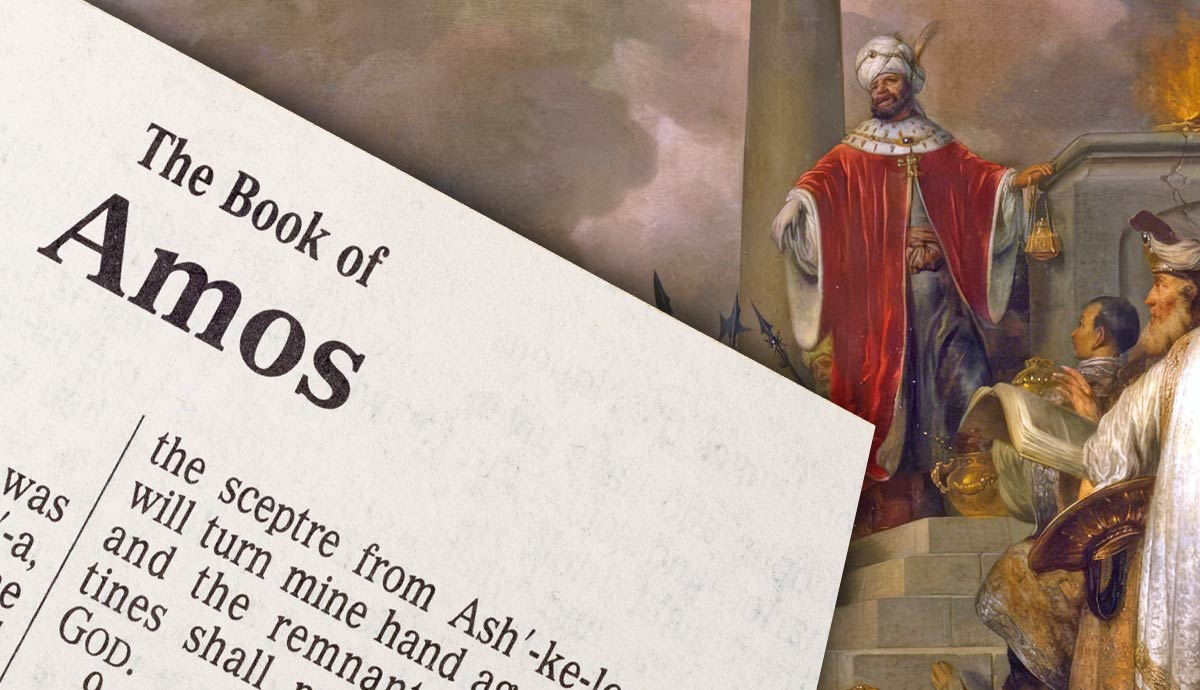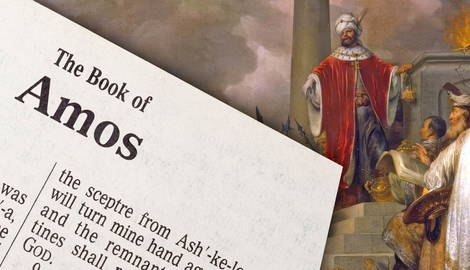
Amos was a prophet from humble origins in the Southern Kingdom of Judah, who ministered primarily to the Northern Kingdom of Israel. He addressed the rampant idolatry and social injustice he encountered, which is attributable to the prosperity the nation experienced during the reign of Jeroboam II in the 8th century BCE. As a foreigner ministering in Israel, the religious elite rejected his message because they benefitted from these practices in Israel. They would not heed the warnings Amos brought and eventually suffered the consequences.
Book of Amos: Authorship and Date

The prophet Amos was from a small town, Takoa, about eleven miles from Jerusalem. The first verse indicates that the record the Book of Amos presents comes from him. However, there is evidence of later editing and addition, probably by copyists who added details relevant to the text after Amos’s death.
Amos self-identified as a shepherd and caretaker of a sycamore-fig grove (Amos 7:14-15) when God sent him to prophesy in Israel. It is uncertain whether he merely worked or owned the flock and grove. His knowledge of history and the Israelite moral and legal traditions indicates that Amos was not a peasant but well-educated. He could have been the author of the book.
Amos ministered in the Northern Kingdom of Israel, though he was from the Southern Kingdom. He prophesied against the idolatry instituted by Jeroboam I during the reign of Jeroboam II, which dates his work to the 8th century BCE. He was a contemporary of Joel, and they shared much of the same message with Israel. Amos, however, also prophesied judgment on Judah among the neighbors of Israel.
Historical Context

After the death of Solomon, the kingdom was divided into the 10 tribes of the Kingdom of Israel and the two tribes of the Kingdom of Judah. 1 Kings 12:28-30 details how Jeroboam I, the king of the Northern Kingdom, established false worship practices in Israel to discourage his people from traveling to Jerusalem in the Southern Kingdom to worship at the Temple. According to Amos 7:10-13, the idolatry practiced there was at the core of Amos’s messages to the frustration of the priests that facilitated it.
Jeroboam II expanded his kingdom through several conquests. It was a time of prosperity in Israel. As often happens, prosperity results in apathy and spiritual decline. Amos noted the social injustices that occurred in Israel and the idolatry which had become the state religion. The king established an alternative religion to dissuade the populace from worshiping in Jerusalem.
Structure

Introduction (Amos 1:1)
The Book of Amos starts with a short introduction of the prophet and the period Amos ministered to Israel.
Judgment against the nations (Amos 1:2-2:16)
The remainder of chapters 1 and 2 focus on the judgment of nations. They were mostly gentile nations like Damascus, Gaza, Tyre, Edom, Ammon, and Moab, but Israel and Judah feature in Amos 2:4-16.
Judgments against Israel (Amos 3:1-6:14)
The focus of Amos turns to Israel. He asks rhetorical questions to show how absurd it was that Israel remained unrepentant. Amos highlighted how prior warnings in the form of famine, drought, and pestilence went unheeded, resulting in the inevitable destruction that would come.
Visions of Judgments (Amos 7:1-9:10)
Amos recorded a series of visions that depicted the realities Israel had to face. The visions included a locust swarm, symbolizing destruction, a fire, which portrayed God’s judgment throughout Israel, a plumb line, which served as a symbol of God’s standards that Israel did not meet, a basket of ripe fruit, which illustrated Israel’s prosperity that was about to end, and the Lord standing by the altar, pointing to impending judgment though it also holds elements of hope.
Restoration (Amos 9:11-9:15)
The Book of Amos ends with words of hope, renewal, and restoration where the exiles could return and rebuild what would be lost. History shows that the Assyrian exile that befell Israel did not result in an eventual return of the ten tribes en masse, like that of the nation of Judah several centuries later. From this, we can deduce that the required repentance and return to God did not occur, resulting in the promise not taking effect. It shows the conditionality of the restoration of the Kingdom of Israel.
Main Themes

Social injustice
Amos recognized how the rich and influential in Israel exploited the poor and marginalized through corruption and indifference. They showed apathy toward the vulnerable, and Amos called for reform. Amos 5:24 reflects his ideal: “But let justice roll down like waters, and righteousness like an ever-flowing stream.”
Religious hypocrisy
Amos called out the hypocritical religious practices of Israel that consisted of outward ceremonies but were void of essence. Amos 5:21-23 expresses God’s rejection of their empty religion.
The Day of the Lord
The sovereignty of God manifests in his judgment of Israel and the surrounding nations. Amos warned of the impending day of the Lord that marks the event where God would execute judgment on those condemned for their unfaithful actions.
Restoration
The last verses of the Book of Amos bring hope to Israel and the nations. The hope comes as promises that God would restore Israel. Amos foretold a time when Israel would prosper, and the fortunes of the House of David would return to their former glory. These promises were conditional on repentance and contrition. The dispersion of the ten tribes of Israel among the nations shows that they never met the requirements for restoration.
Key Passages

Amos 2:6
“Thus says the LORD: “For three transgressions of Israel, and for four, I will not revoke the punishment, because they sell the righteous for silver, and the needy for a pair of sandals—those who trample the head of the poor into the dust of the earth and turn aside the way of the afflicted; a man and his father go in to the same girl, so that my holy name is profaned… ”
This verse is a strong indictment of Israel for the social injustice that was commonplace in the nation. Corruption and greed chipped away at the fabric that held Israelite society together. The immoral actions of the leaders and elites of Israel called for justice from God.
Amos 3:3
“Do two walk together, unless they have agreed to meet?”
In Old Testament times, walking together symbolized unity, shared purpose, alignment, and partnership. It expresses the relationship between the parties on a journey. In this instance, it expressed that in the covenant relationship, God and Israel were not aligned.
Amos 4:12
“Therefore thus I will do to you, O Israel; because I will do this to you, prepare to meet your God, O Israel!”
This verse called the nations to account for their sins. It was no human court where justice could be manipulated. Justice was in the hands of God, who saw and knew of all the wrongdoings of Israel.

Amos 5:4
“For thus says the LORD to the house of Israel: ‘Seek me and live; but do not seek Bethel, and do not enter into Gilgal or cross over to Beersheba; for Gilgal shall surely go into exile, and Bethel shall come to nothing.’”
In God’s mercy, he called on Israel to repent and seek him so they could receive grace. He showed two paths: the path that leads to him and life, and the path through places associated with idolatry that would lead to destruction.
Amos 7:10
“Then Amaziah the priest of Bethel sent to Jeroboam king of Israel, saying, ‘Amos has conspired against you in the midst of the house of Israel. The land is not able to bear all his words. For thus Amos has said, “Jeroboam shall die by the sword, and Israel must go into exile away from his land.”’ And Amaziah said to Amos, ‘O seer, go, flee away to the land of Judah, and eat bread there, and prophesy there, but never again prophesy at Bethel, for it is the king’s sanctuary, and it is a temple of the kingdom.’”
Amaziah, priest of Bethel, the hub of idolatry in Israel, rejected the messages Amos brought and wished Jeroboam to consider Amos a traitor, undermining the King of Israel. He wanted Amos banned from the Northern Kingdom to rid the nation of the messages of impending judgment.
Contemporary Relevance

Amos reminds the reader of the importance of living a life of faith that is authentic. Authentic faith will manifest in social justice and be void of empty ceremonies. The book also shows the willingness of God to forgive even in the light of grievous sins such as idolatry. However, repentance and contrition are necessary for mercy to avail. Amos shows that God wants to restore the broken and sinful to a prosperous existence.










